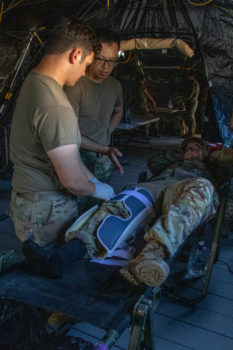
FORT KNOX, Ky. – As the 2023 Cadet Summer Training program is starting up, the 581st Area Support Medical Company (ASMC), 61st Multi-functional Medical Battalion, 1st Medical Brigade, 13th Sustainment Command (Expeditionary) from Fort Cavazos, Texas, are operating a role II field hospital support at Fort Knox. Located at Logistic Support Area Baker, the role II field hospital is set up to provide medical treatment and exercises for the Cadets that are training.
The groups from Fort Cavazos began to prepare for their visit to Fort Knox for the mass casualty evacuation (CASEVAC) exercise by perfecting their role II operations and making sure all their equipment was working properly. The Army Soldiers and medics checked that the tents were not ripped or damaged, packed up the tents and all the medical equipment that they thought they would need into boxes, and shipped them to Fort Knox around a month prior to their arrival. Once the medics all arrived on base, they worked together to assemble the tents with flooring, and they were able to set up their medical equipment as well as air conditioning once the generators and power were hooked in. It took the crew only a couple of hours to get the tents up and running, and they met their goal of being able to see potential patients within an hour of getting on ground.
U.S. Army Spc. Mirna Zolorzano, 581st ASMC, explained how the general purpose of role II is to provide medical care for injured Soldiers since Fort Knox does not have a hospital or other medical assets.
“We have an X-ray lab, behavioral heath capabilities, as well as supplies for the medics,” Zolorzano said. “Most of the time, people come in to see the medics for injuries, heat casualties, if they have a sore throat or something, and the medics will take care of that with the providers.”
It is faster and more convenient for the Cadets to be treated at role II instead of needing to leave the base if they were to seek medical attention.

Since they are not expecting to see any extreme trauma cases during the CST program like they are used to, U.S. Army Sgt. Brandon Acevedo, 566th ASMC, described how the Army medics and Soldiers prepare each other and Cadets by going through injury scenarios to gain more hands-on experience.
“We would do a lot of scenarios; we’ll present a patient to our medics, and our medics will ask questions that they would like a normal patient to get them more ready for that kind of interaction,” said Acevedo. “We’re hoping to give them that first taste of real Army.”




